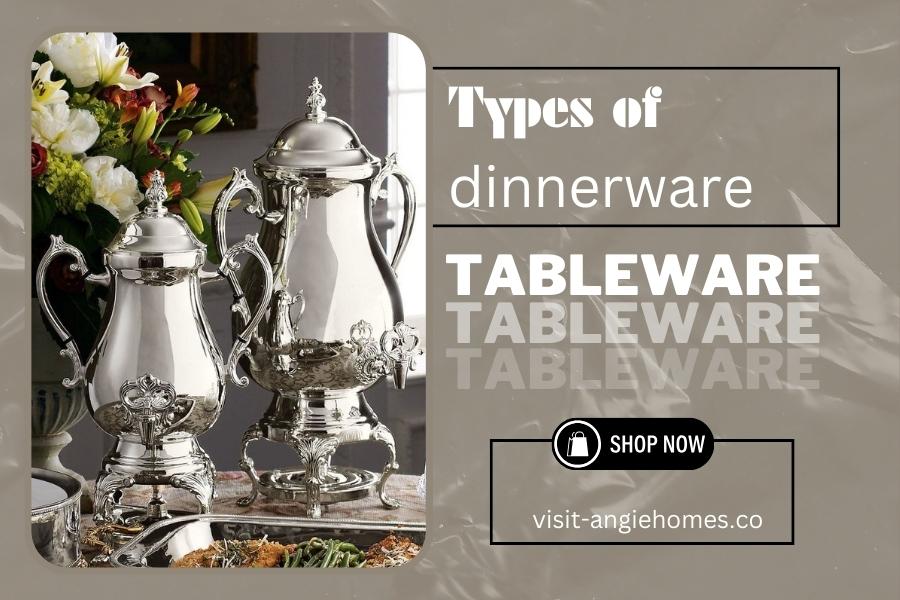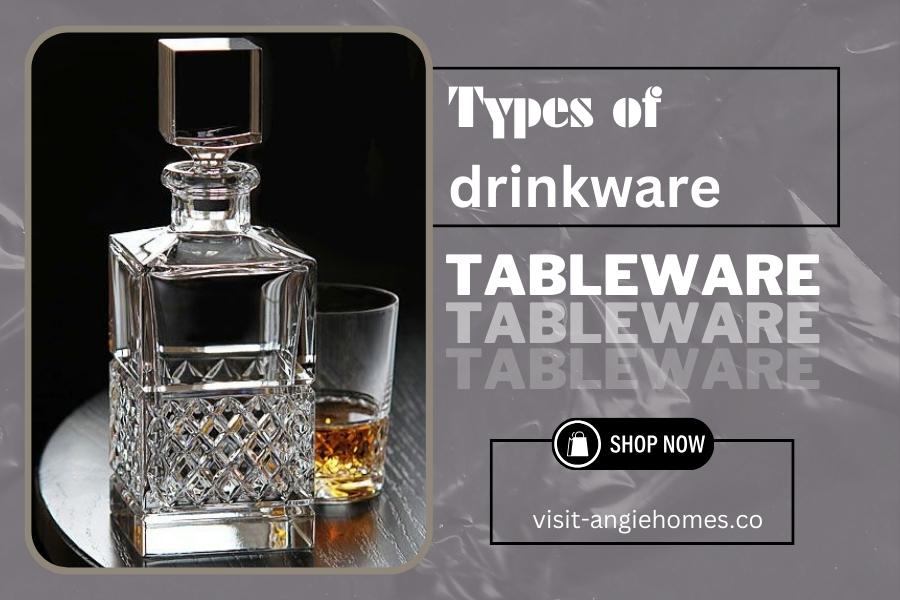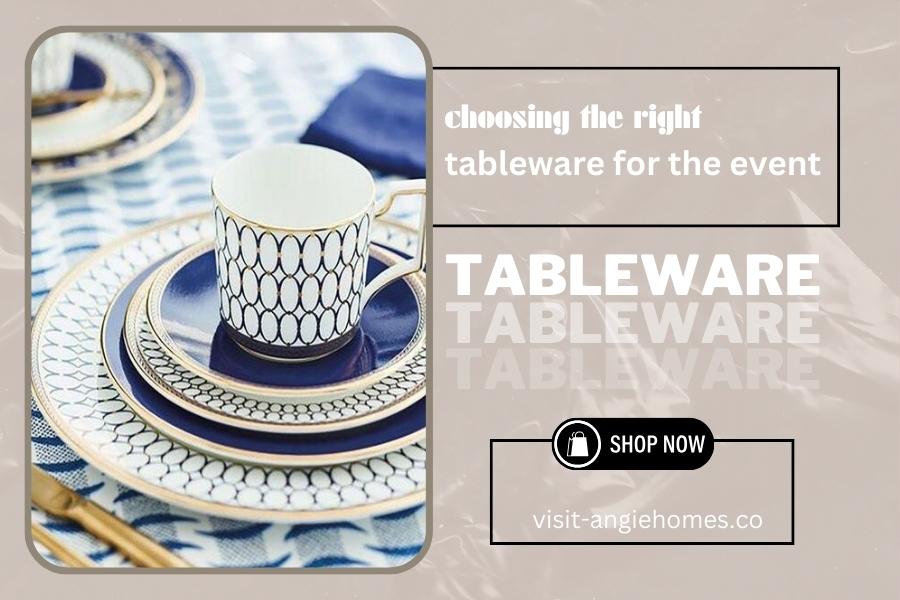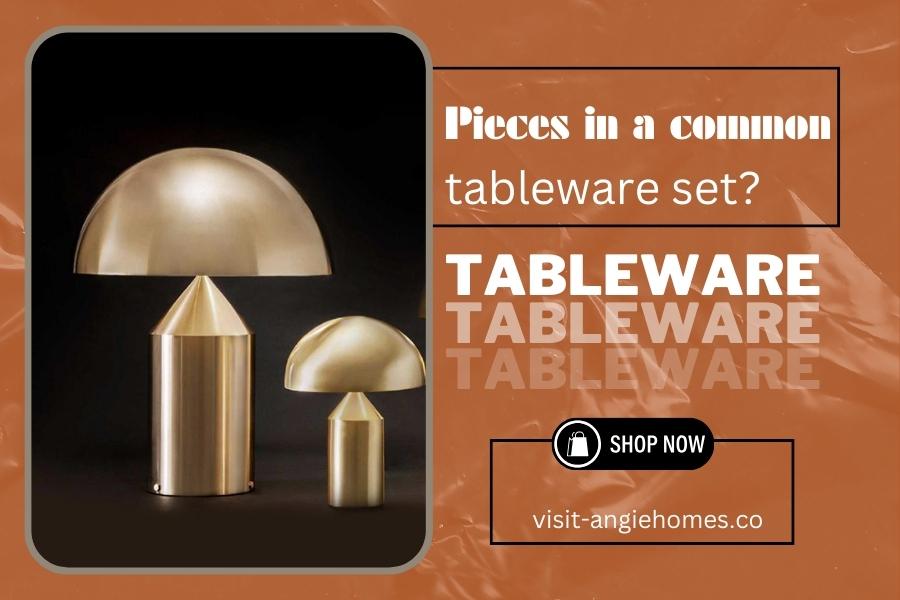Tableware, often taken for granted, plays a significant role in enhancing our dining experiences. Beyond their functional purpose, tableware items are expressions of creativity, culture, and elegance. This comprehensive guide will delve into the world of tableware, exploring its various types, materials, and the etiquettes surrounding its use. Whether you're setting the table for a casual family dinner or a grand formal event, understanding tableware can make a world of difference.
Getting To Know Each Type of Tableware

Tableware comes in an array of forms, each designed for a specific purpose. Let's explore some of the primary types:
Types of Dinnerware

Dinnerware comprises the plates, bowls, and serving dishes used for meals. There are several types to choose from:
Dinner Plates
The largest and most common, used for serving main courses. These are the canvas upon which culinary masterpieces are presented, making them a focal point of the dining experience. You can find them in various shapes, from round to square, and in materials ranging from porcelain to stoneware.
Salad Plates
Smaller than dinner plates, salad plates are ideal for salads or appetizers. They provide the perfect backdrop for showcasing vibrant greens and colorful dressings. Opt for salad plates that complement your dinnerware set.
Soup Bowls
Deeper bowls designed for soups, stews, and chili. Soup bowls often have a wide, shallow design to allow for easy spoon access and even cooling. Materials like porcelain and ceramic are commonly used for their insulating properties.
Dessert Plates
Smaller plates designed specifically for serving desserts or snacks. Their diminutive size encourages portion control, making them ideal for indulging in sweet treats without overindulgence.
Serving Platters
Large, flat dishes for presenting main courses or appetizers. Serving platters come in various shapes and sizes, from oval to rectangular. They are often designed to complement the overall aesthetic of your dinnerware.
Gravy Boats
Specialized dishes for serving gravy or sauces. These elegant vessels typically have a spout for easy pouring and a comfortable handle for stability. Gravy boats elevate the process of sauce distribution, adding a touch of refinement to the table.
The Materials You Can Find Dinnerware
Dinnerware can be crafted from various materials, each offering unique qualities:
Porcelain
Known for its delicate appearance and durability, porcelain is a classic choice for dinnerware. Its smooth, non-porous surface makes it easy to clean, and it's resistant to staining and chipping.
Porcelain dinnerware often features intricate patterns and designs, making it a favorite for formal occasions.
Stoneware
A bit more substantial than porcelain, stoneware is versatile and perfect for everyday use. It has a slightly rougher texture and can handle the rigors of daily meals. Stoneware dinnerware often boasts earthy tones and rustic designs, adding warmth to your table.
Bone China
Elegant and lightweight, bone china has a translucent quality that exudes sophistication. It's made from a blend of bone ash, porcelain clay, and china stone, resulting in a delicate yet resilient material. Bone china dinnerware is prized for its exquisite designs and refined appearance.
Earthenware
Rustic and charming, earthenware often features hand-painted designs. While it's not as durable as porcelain or stoneware, it adds a touch of artisanal beauty to the table. Earthenware dinnerware is best suited for casual dining and special occasions with a relaxed vibe.
Melamine
Durable and resistant to breaking, melamine dinnerware is ideal for outdoor dining, picnics, and family gatherings. It mimics the appearance of ceramic or porcelain but is virtually unbreakable. Melamine plates and bowls come in various colors and patterns, adding a cheerful touch to your table.
Types of Drinkware

Drinkware includes glasses, cups, and mugs. Here are some common types:
Wine Glasses
Designed to enhance the flavors and aromas of wine, wine glasses come in various shapes to accommodate different wine varieties. Red wine glasses typically have a larger bowl to allow for aeration, while white wine glasses have a narrower bowl to preserve the wine's crispness.
Water Glasses
Suitable for serving water and other non-alcoholic beverages like juice or soda. Water glasses are typically simple and versatile, complementing any table setting.
Cocktail Glasses
Various shapes of cocktail glasses are tailored to specific cocktails, such as martini glasses, highball glasses, and margarita glasses. These glasses not only serve a functional purpose but also contribute to the visual appeal of the cocktail.
Coffee Mugs
For serving coffee or tea, coffee mugs come in a wide range of styles and sizes. They may have handles or be handle-less, and their designs can range from minimalist to whimsical.
Tumblers
Versatile glasses for a wide range of beverages, including water, iced tea, and soft drinks. Tumblers are sturdy and practical, making them suitable for everyday use. They often come in sets, making them a convenient choice for family gatherings.
Choosing The Right Tableware for Your Event

Selecting the right tableware for an event is essential to create the desired atmosphere. Consider these tips:
- Occasion: The formality of the event should guide your tableware For formal events like weddings or elegant dinner parties, opt for fine china or porcelain dinnerware. For casual gatherings, stoneware or earthenware adds a cozy touch.
- Theme: If your event has a specific theme or color scheme, choose tableware that complements For a beach-themed party, consider coastal-inspired dinnerware. For a rustic farmhouse dinner, choose earthy-toned stoneware.
- Guests: Consider the number of guests and the dishes you'll be serving. Ensure you have enough plates, bowls, and drinkware to accommodate It's also a good idea to have some extras on hand in case of accidents.
- Practicality: Consider how easy the tableware is to clean and While delicate porcelain is stunning, it may not be practical for large gatherings where quick cleanup is essential. Melamine, on the other hand, is virtually indestructible and a breeze to clean.
- Budget: Stick to a budget that aligns with your event's scale. There are tableware options available at various price points, allowing you to find the perfect balance between quality and affordability.
Major Classifications of Tableware

Tableware can be classified into four main categories:
- Flatware: Includes utensils like forks, knives, and Flatware is an essential part of any table setting and plays a crucial role in how diners interact with their meals. It comes in various styles, from modern to traditional, to suit different table settings.
- Dinnerware: Comprises plates, bowls, and serving Dinnerware serves as the canvas for your culinary creations, setting the tone for the meal. The choice of dinnerware can convey elegance, informality, or a particular theme.
- Drinkware: Includes glasses, cups, and Drinkware not only holds beverages but also enhances the drinking experience. The shape and design of drinkware can affect the aroma, taste, and presentation of drinks.
- Serveware: Consists of platters, trays, and other serving Serveware plays a functional role in presenting and distributing food to diners. It often complements the overall tableware theme and adds practicality to the dining experience.
Pieces in a Common Tableware Set

A standard tableware set typically includes:
- Dinner Plates: These are the foundation of your table setting, where the main course takes center
- Salad Plates: Perfectly sized for appetizers or salads, they add versatility to your place
- Soup Bowls: Deep and spacious, soup bowls are designed to hold comforting soups and
- Dessert Plates: Smaller plates dedicated to sweet indulgences, making dessert a memorable
- Cereal Bowls: Deep bowls for serving cereal, oatmeal, or other breakfast
- Coffee Cups and Saucers: Elegant cups for serving coffee or tea, often accompanied by saucers for
- Mugs: Larger and cozier than coffee cups, mugs are ideal for those who enjoy a heartier
- Serving Platters: Large, flat dishes for presenting main courses or appetizers with
- Serving Bowls: Deep bowls for serving salads, side dishes, or pasta, adding variety to the
- Gravy Boat: A special dish with a spout for serving gravy or sauces with precision and
- Butter Dish: A charming container for serving butter, often accompanied by a lid to keep it
- Salt and Pepper Shakers: Small containers for dispensing salt and pepper, placed strategically on the table for seasoning
- Sugar Bowl and Creamer Set: A delightful duo for coffee and tea enthusiasts, elevating the
- Teapot or Coffee Pot: Gracefully designed vessels for serving hot beverages, fostering a sense of tradition and
How Should the Dishes be Placed?

Proper table setting etiquette is essential for formal occasions. Here's a basic guide:
- Dinner Plate: Place the dinner plate in the center of each chair's designated Ensure that it's level with the table's edge.
- Salad Plate: Position the salad plate to the left of the dinner plate, slightly above the It's the second plate from the center.
- Forks: Arrange forks on the left side of the dinner The salad fork should be on the outside, followed by the dinner fork closer to the plate.
- Knives: Place knives on the right side of the dinner plate, with the blade facing the The dinner knife should be on the inside, and the salad knife, if needed, should be on the outside.
- Spoons: Set spoons to the right of the The soup spoon, if required, should be on the outside, followed by the dessert spoon closer to the plate.
- Glassware: Position the drinking glasses (water and wine glasses) above the knives and spoons, to the right. The water glass should be closer to the tip of the knife, while the wine glasses can follow inorder.
- Napkin: You can either fold the napkin neatly and place it on the dinner plate or position it to the left of the forks. Alternatively, you may choose to use napkin rings or creative folding techniques to add an extra touch of
Conclusion
Tableware isn't merely a functional aspect of dining; it's an art form that enhances our culinary experiences. By understanding the different types, materials, and etiquette surrounding tableware, you can elevate any meal into a special occasion. Whether you're hosting an intimate gathering or a lavish event, the right tableware sets the stage for a memorable dining experience.
At Angie Homes, we understand the importance of selecting the perfect tableware for your occasions. We offer a curated selection of exquisite tableware that combines elegance, functionality, and style. Our range includes a variety of dinnerware, drinkware, and serveware options to suit your unique preferences and the theme of your event.
Explore Angie Homes' collection and discover tableware that not only complements your culinary creations but also adds a touch of sophistication to your dining settings. From fine china to versatile stoneware, our tableware options cater to various occasions and preferences, ensuring that every meal is a delightful experience.
FAQ's (Frequently Asked Questions)
Q. What’s The Difference Between Tableware And Flatware?
Ans: Tableware encompasses all items used for dining, including dinnerware, drinkware, and serveware. Flatware refers specifically to utensils like forks, knives, and spoons. While tableware is the entire ensemble, flatware is just a part of it.
Q. Should I Rent Or Buy Tableware?
Ans: The choice between renting or buying tableware depends on the frequency of use and your budget. For occasional events, renting can be cost-effective, while buying is ideal for regular use. Consider your long-term needs and the convenience of ownership versus the cost-effectiveness of renting.
Q. What do you mean by tableware?
Ans: Tableware refers to all the items, including dishes, glasses, and utensils, that are used for serving and eating food and beverages during meals. It encompasses everything you need to set a table for dining.
Q. What is tableware and its types?
Ans: Tableware includes various types of items used for dining, such as dinnerware (plates and bowls), drinkware (glasses and cups), flatware (utensils), and serveware (platters and serving dishes). The types of tableware can vary in terms of design, material, and purpose.
Q. What are the 4 classifications of tableware?
Ans: Tableware is typically classified into four main categories: flatware (utensils), dinnerware (plates and bowls), drinkware (glasses and cups), and serveware (platters and serving dishes). Each classification serves a distinct role in the dining experience.
Q. What items are tableware?
Ans: Tableware includes a wide range of items used in dining, such as plates, bowls, glasses, cups, utensils, serving platters, and various accessories like napkin rings and butter dishes. These items collectively contribute to the aesthetics and functionality of a dining table.
